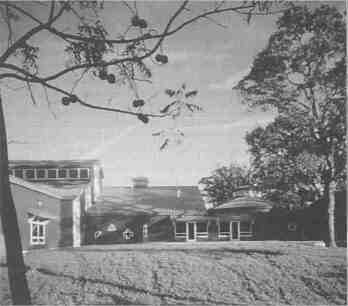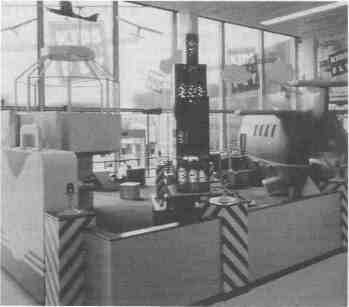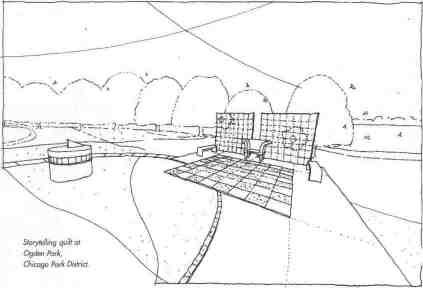SPECIAL FOCUS
Designing Spaces for Kids
Children's museums are all about learning by doing, and this philosophy translates to their design
BY PETER EXLEY, AIA, AND SHARON EXLEY
|
Children's museums
are a relatively
recent phenomenon
and have always
been about learning
through play. And,
for those of you
who can't recall,
that involves a lot of
exploring, touching,
running, smelling,
jumping, tasting,
listening and
making noise.
|
Many of us recall the museums of our youth as
dusty Victorian establishments filled with cases,
endless text and, if we were lucky, a single button that
when pressed sometimes activated a model of a steam
engine or other fascinating feat of engineering.
Today, families visit museums expecting a tactile,
multisensory experience. Successful museums are
now as much about doing and learning through
experience, as they are about showing and seeing.
Concurrently, other spatial environments see changes
happening too. Perhaps taking a lead from museums,
parks and other civic spaces are encouraging more
interaction and experience.
It's not all about touching. An art museum can't let
you feel the brush strokes on its van Gogh, but it
might let you focus in on it, teach you how to look in
new ways, then lead you to a studio where you
experiment with real paint and real brush strokes. A
science museum introduces you to robotics by letting
you "play" with its souped-up Lego exhibit. Even the
local historical society transforms into Main Street to
host an old-fashioned 4th of July parade.
Nowhere has the envelope been pushed more than
with children's museums. Interestingly, unlike long
established science museums or art galleries, the
children's museum has never had to reinvent itself.
With a couple notable exceptions, children's museums are a relatively recent phenomenon and have
always been about learning through play. And, for
those of you who can't recall, that involves a lot of
exploring, touching, running, smelling, jumping,
tasting, listening and making noise.
Museums as Communities
Many children's museums begin as grassroots
organizations in small communities or neighborhoods. Often, it's a few motivated parents or teachers
who provide the impetus. The sense of community
ubiquitous to any children's museum makes relationships between park districts (or other public agencies) and these institutions mutually beneficial. The
range of collaboration varies: the DuPage Children's
Museum has leased space from the Wheaton Park
District for several years, while the Arizona Museum
For Youth in Tempe, Ariz., is actually a department
of its city's government.
Common to all of these unique relationships is the
dedication to a mission of serving communities and
families. Children's museums are very tangible
beacons: not only are they cultural assets, but a
source of community pride, catalysts for tourism, as
well as diverse places of inspiration for children and
their care-givers.
Creating a Museum
Requires Partners
Of course, museums don't happen overnight. A
grassroots committee is well-advised to seek collaborations with key individuals and organizations in
developing its mission, its programs and its ultimate
home.
Developing key strategies and leadership in the
fields of fund-raising, architecture and design (of
both building, or adaptive reuse and exhibits)
alongside programming are all essential first steps in
January/February 1999 /39
creating a museum. In our experience, we stress the
value of a collaborative effort in planning and
developing a museum and its exhibits. The perspectives and issues involved in design, education, and
project management are inseparable. All need
experienced and dedicated advocates.
A Design Philosophy
"Educative design" is a philosophy that we have
created from our unique perspective as both educators
and designers of environments for children. It's a
good expression of the importance of design that
educates, and design that is educated. This provides
direction, criteria and approaches to design and
recognizes the following:
• pragmatic and developmental needs of all users are
a foundation of good design;
• a desire to inspire through environment and
experience; and
• designers, educators and clients have common
pragmatic, developmental and inspirational values
and needs that form the basis of a good program.
The three examples that follow have educative
design as their core philosophy.
Bourbonnais' Exploration Station -
The Educative Design Process
In 1994, the Exploration Station, a children's
museum and facility of the Bourbonnais Township
Park District, felt ready to expand from a small rented
facility. They approached our firm, Peter J. Exley
Architect, as specialists in educative design. A local
architect was included to interact with our specialized
firm. The interaction afforded a relatively small
community the opportunity to work with a design
team with expertise in cutting-edge museum design.
From the outset, dialog with the local community
was integral to the project. Key presentations and
meetings amassed information, opinions and reactions
that were then interpreted using the educative design
process. All such projects benefit from the contributions of the following groups and individuals:
• community and local interest groups;
• focus groups (residents, families, teachers, local
business, etc.);
• museum board of directors (if applicable); and
• local media.
|

Photo; Bourbonnais'
Exploration Station balances a
facility for children
play and learn with the natural setting of
Perry Farm. Photograph by
Doug Snower Photography.
|
Initial focus groups helped articulate "wish lists" of
children, care-givers and others alike, as well as
introducing everyone to the process of design and
architecture. These exchanges were very much a two-
way street of learning for both architect and the
community.
There were many public presentations as the design
progressed, and local media ran articles, publishing
drawings as they became available. Maintaining
public ownership of a museum as it evolves is crucial
in gauging reaction. Igniting action by investing
individuals and businesses in their new museum is
integral to the process of educative design.
Another major challenge posed by the Exploration
Station was its site on the Perry Farm property. The
location was pristine on acres of park reserve alongside
the Kankakee River. The placement of a building
sensitive to the site, but also reflecting the buildings
function was an interesting challenge. Ultimately the
museum became a series of buildings that looked as
though they belonged on a farm.
|
Giving children a sense of ownership and security
in their museum grew from the educative design
philosophy. The museum is clearly intended for
children with features such as an "A thru Z Garden"
taking advantage of the building's orientation to
outdoor play spaces. Varying scales of interior space,
whimsical shaped windows (great opportunities to
view the world from inside and out, from different
vantages), and some unusual materials and colors
reinforce and emphasize the function of the structure
too.
Nestled in the preserved landscape, many visitors
wonder whether the building is a renovation of
40/ Illinois Parks and Recreation
existing structures. No trees were felled, and the
building was designed to sit within the existing shade
of several mature oaks. So, designing the building to
be attractive architecture is in many respects
subservient to recognizing its potential as a place for
play, learning, tourism, public assembly, and fun.
The key to the Exploration Station's success has its
roots in the architect, community and client coming
to know each other, spending time and working
together. Maintaining this relationship beyond the
opening of the museum is important too. Even
though the Exploration Station is now open, it's
important to review how the building functions and
to integrate change within the design.
"Kids On The Fly" - A Lesson in the
Museum as Public Entity
There are many pragmatic issues inherent to the
building process that are sometimes magnified when
a community decides to build a museum. These are
increased when that museum is geared to children
and further compounded when that facility becomes
part of a public domain.
Invariably, safety is always crucial in design of
environments. Above all else, it is the one thing that
everyone is ultra-sensitive to in the design of projects
for children. Beyond the use of materials and
detailing (e.g., fall zones and corners), the paradoxes
of means of egress and single supervised points of
entry and exit challenge every design and require
careful investigation, consultation with specialist
agencies, and thorough implementation.
Kids On The Fly is a satellite facility under the
joint banner of the Chicago Children's Museum and
the City of Chicago Department of Aviation in
O'Hare International Airport. It is really like an
indoor park, saturated with activities for families.
Both these institutions, already acutely sensitive and
attentive to all aspects of safety and welfare, approached the design and development of this project
with extraordinary care.
Kids On The Fly paid extreme attention to issues
of accessibility, working throughout with the Mayor's
Office For People With Disabilities. A primary goal
in this project was enabling every child, care-giver or
visitor exemplary access to this experience. To that
end, audible and tactile interpretation of the project
is available, and the best way to access the exhibits
centerpiece cargo plane is via a ramp lined with
interactive cargo and fabulous views of O'Hare's
runways. It's a magnificent proactive solution.
|

Photo: Kids On the Fly is a satellite
facility of the Chicago Children's
Museum located inside Chicago's
O'Hare International Airport.
Photograph by Doug Snower
Photography.
|
There's a wonderful balance of the pragmatics,
developmentals and inspirationals that are the
foundation of "educative design in action" at Kids
On The Fly. In the design process, this also extends
to apportionment of realistic schedules and budgets.
Recognizing too, the sensitive issues of any
organization's ability to raise funds, their reliance
upon pro-bono contributions (very few children's
museum projects exist without significant in-kind
contributions), and a myriad of other criteria are
unique to every such project and location.
Frequently, pragmatic issues such as these may
seem to overshadow issues of development or
educational mission, or even inspirational aspirations of design. We have found that thoughtful and
completely successful pragmatic resolutions invariably lead to wonderfully challenging and inspiring
environments and museums. Often we have
observed that overly focusing on inspirational
criteria can lead to rather awkward ill-functioning
conditions without much needed inherent flexibility.
|
Ogden Park - Parks Designed for
Children and Interaction
Many museums are successful places for learning,
of play, entertainment, and even retail experience.
So perhaps it isn't surprising that other types of
institutions look toward the successes of museums
in their interaction with children and care-givers.
Recently, our team collaborated with Wolff
Clements Landscape Architects and the Chicago
Park District on the creation of a prototype neighborhood park at 63rd and Racine Streets in Chicago.
A small conventional playground and large play-
lot within Ogden Park has given way to a secure,
contained landscaped environment complete with
interactive water features, flexible inspirational areas
geared to art-making, storytelling, family outings (or
whatever use creative camp leaders, teachers or care-
January/February 1999 /41
SPECIAL FOCUS
givers can assign), a carrousel, a performance area, lots of places to sit, as well as a
huge array of the latest play equipment.
In part, a project like this owes much to
the ground-breaking explorations of
children's museums. The creation of a
beautiful park results from the creation of a
nurturing haven providing experience and
interaction for individuals, families and
organizations in the community and
neighborhoods of the city around it. The
experience and interaction is inspired by
the collaboration of voices in that community, the designers, and a committed park
district.
Lessons Learned
The recognition of the importance and
power of play in the development of
children, the importance of adult interaction in that development and the commitment of public and private, for-profit and
charitable organizations are criteria crucial
to the creation of meaningful places and
spaces for children, their families and schools.
|

Story telling quilt at Ogden park,Chicago Park District
|
Many times, we have found, the children's museum
exemplifies excellent chemistry in that regard. And
there are many lessons in the process of educative
design that can be applied successfully to enhance our
approach to the design challenges in the parks and
buildings of our communities. A project such as
Ogden Park illustrates a new generation of experimental environment. The reality that, in a conventional
sense, this is a park is a poignant observation illustrating the potential of all public spaces and the opportunities inherent to educative design.
Realizing the potential of projects that thrive on
public interaction (including museums and parks), as
places that are about doing and experiencing, is an
irresistible challenge. The possibilities that exist
through the use of educative design are a wonderful
directive for elevating the qualities of our built
environments with new experiences. •
|
PETER EXLEY AIA
is a principal of Peter J. Exley Architect, a Chicago-based firm that dedicates a lot of
its energy to the design of environments and architecture for children, play and
recreation. Contact information: Peter J. Exley Architect, 111 W. North Avenue,
Chicago, III., 60610-1302, 312.335.1317.
SHARON EXLEY
specializes in 'educative design' and is a principal of the firm.
Resources for children's museums and start-ups: the Association or Youth Museums or
AYM (202.466.4144) and American Association of Museums (202.289.1818),
both in Washington, D.C. For more resources, see page 26 of this issue of IP&R.
42/ Illinois Parks and Recreation


